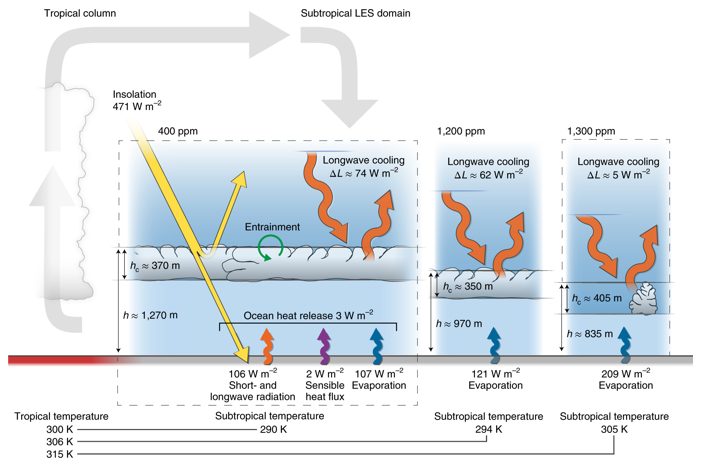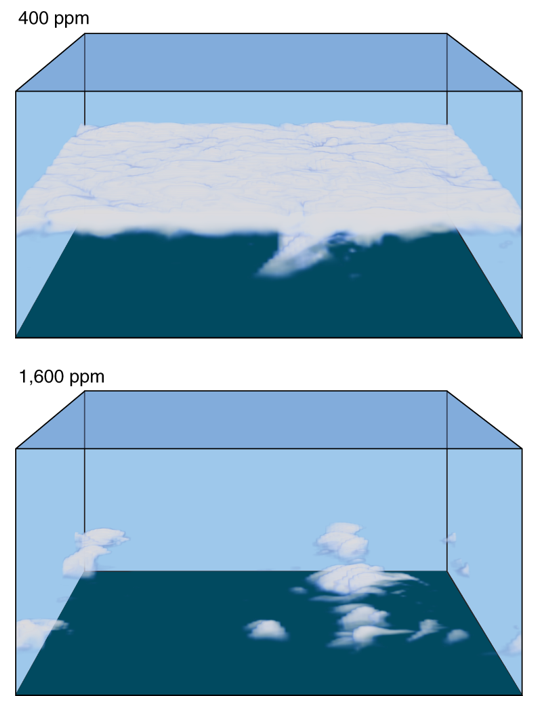Loss of marine stratocumulus clouds could trigger a mega-hothouse climate – “Transitions to a much warmer climate may occur in the future if CO2 levels continue to rise”

By Dr. Jeff Masters
6 May 2019
(Weather Underground) – If humanity maintains its current business-as-usual emissions path for the next 100 years, the resulting 4°C (7°F) of warming may be enough to cause highly reflective stratocumulus clouds over the subtropical and tropical oceans to disintegrate, resulting in an additional 8°C (14°F) of warming, according to research published in February. The resultant “Hothouse Earth” climate, 12°C (22°F) warmer than pre-industrial levels, would be enough to melt all ice on the planet, raise sea levels by over 200 feet over a period of centuries, and produce heat waves too hot for humans to endure outdoors for over half of Earth’s population (as currently distributed.)
The paper, from a team of California Institute of Technology scientists led by Tapio Schneider, was called Possible climate transitions from breakup of stratocumulus decks under greenhouse warming. The study used a specialized ultra-high-resolution model (50-meter grid size) that was detailed enough to resolve individual updrafts and downdrafts in stratocumulus clouds. Global climate models, with their grid sizes of ten of kilometers, cannot resolve such fine-scale processes. The new model found that when carbon dioxide concentrations increased from current levels of about 410 ppm to 1200 ppm, stratocumulus clouds over the subtropical and tropical oceans became unstable and broke up into scattered cumulus clouds. […]
The current business-as-usual emissions path humanity is on, called RCP8.5, has Earth’s atmosphere reaching carbon dioxide levels around 1100 ppm by the year 2100. This scenario would require the world to massively expand coal use and not make additional efforts to reduce greenhouse gases over the rest of this century, and is considered unlikely by some. However, as explained in our 2 April 2019 post, Global CO2 Emissions Hit an All-Time High in 2018; is a Hothouse Earth in our Future?, even if we manage to limit global warming to the Paris Accord target of 2.0°C above pre-industrial levels, we might cross a threshold that would set in motion amplifying feedbacks that could well push irreversibly into such a “Hothouse Earth” state over a period of centuries, taking us beyond the 1200 ppm of CO2 threshold. [more]
Losing Marine Stratocumulus Clouds Could Create a Mega-Hothouse Climate

ABSTRACT: Stratocumulus clouds cover 20% of the low-latitude oceans and are especially prevalent in the subtropics. They cool the Earth by shading large portions of its surface from sunlight. However, as their dynamical scales are too small to be resolvable in global climate models, predictions of their response to greenhouse warming have remained uncertain. Here we report how stratocumulus decks respond to greenhouse warming in large-eddy simulations that explicitly resolve cloud dynamics in a representative subtropical region. In the simulations, stratocumulus decks become unstable and break up into scattered clouds when CO2 levels rise above 1,200 ppm. In addition to the warming from rising CO2 levels, this instability triggers a surface warming of about 8 K globally and 10 K in the subtropics. Once the stratocumulus decks have broken up, they only re-form once CO2 concentrations drop substantially below the level at which the instability first occurred. Climate transitions that arise from this instability may have contributed importantly to hothouse climates and abrupt climate changes in the geological past. Such transitions to a much warmer climate may also occur in the future if CO2 levels continue to rise.
Possible climate transitions from breakup of stratocumulus decks under greenhouse warming

FAQ: Possible climate transitions from breakup of stratocumulus decks under greenhouse warming
By Tapio Schneider
1 March 2019
(CliMA) – There are several questions that have been asked frequently about our recent paper in Nature Geoscience. Here are answers to some of them.
- What are stratocumulus clouds?
Stratocumulus are low-lying clouds with tops typically below 2 km (7000 ft) altitude. They are the most frequent cloud type on Earth and, over oceans, often form nearly unbroken decks covering thousands of square kilometers. In the subtropics, they are especially prevalent over eastern ocean basins, for example, off the coasts of California, Peru/Chile, and Namibia/Angola. - Why are they important for Earth’s climate?
Stratocumulus clouds cover about 20% of the tropical ocean area (between 30°S and 30°N). Because they reflect much of the sunlight incident on them back to space, they shade and cool Earth’s surface. This makes stratocumulus clouds important for regulating Earth’s surface temperature globally. It has long been recognized that increasing the fraction of the globe they cover by a few percent can lead to substantial global cooling; conversely, decreasing the area they cover can lead to substantial global warming. […] - What are the implications?
Climate transitions that arise from the stratocumulus instability may have contributed importantly to abrupt climate changes and very warm climates in Earth’s geological past. For example, geological records indicates that around 50 million years ago (during the Eocene) Earth was very warm. It was unclear, however, how such a warm climate could arise given estimates that CO2 was less than 2,000 ppm. Current climate models do not reproduce warm enough climates with CO2 levels below 2,000 ppm. Our study suggests a possible mechanism of how such warm climates, and transitions between different climate states, may have arisen.
The study points to a blind spot in climate modeling: climate models do not simulate stratocumulus clouds and their climate change response well, and we urgently need to improve this.
It cannot be excluded that stratocumulus decks break up if CO2 levels continue to rise rapidly for over a century. However, it is unlikely that we will reach such high CO2 levels, and climate change would have severe and dangerous global impacts well before the loss of stratocumulus decks. [more]
FAQ: Possible climate transitions from breakup of stratocumulus decks under greenhouse warming